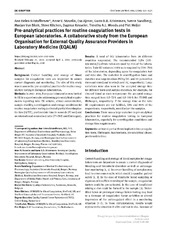| dc.contributor.author | Kristoffersen, Ann-Helen | en_US |
| dc.contributor.author | Stavelin, Anne | en_US |
| dc.contributor.author | Ajzner, Éva | en_US |
| dc.contributor.author | Kristensen, Gunn Berit Berge | en_US |
| dc.contributor.author | Sandberg, Sverre | en_US |
| dc.contributor.author | van Blerk, Marjan | en_US |
| dc.contributor.author | Kitchen, Steve | en_US |
| dc.contributor.author | Kesseler, Dagmar | en_US |
| dc.contributor.author | Woods, Timothy A.L. | en_US |
| dc.contributor.author | Meijer, Piet | en_US |
| dc.date.accessioned | 2020-05-11T12:10:04Z | |
| dc.date.available | 2020-05-11T12:10:04Z | |
| dc.date.issued | 2019 | |
| dc.Published | Kristoffersen A, Stavelin A, Ajzner É, Kristensen GBB, Sandberg S, van Blerk M, Kitchen S, Kesseler D, Woods, Meijer P. Pre-analytical practices for routine coagulation tests in European laboratories. A collaborative study from the European Organisation for External Quality Assurance Providers in Laboratory Medicine (EQALM). Clinical Chemistry and Laboratory Medicine. 2019;57(10):1511–1521 | eng |
| dc.identifier.issn | 1437-4331 | |
| dc.identifier.issn | 1434-6621 | |
| dc.identifier.uri | https://hdl.handle.net/1956/22180 | |
| dc.description.abstract | Background: Correct handling and storage of blood samples for coagulation tests are important to assure correct diagnosis and monitoring. The aim of this study was to assess the pre-analytical practices for routine coagulation testing in European laboratories. Methods: In 2013–2014, European laboratories were invited to fill in a questionnaire addressing pre-analytical requirements regarding tube fill volume, citrate concentration, sample stability, centrifugation and storage conditions for routine coagulation testing (activated partial thromboplastin time [APTT], prothrombin time in seconds [PT-sec] and as international normalised ratio [PT-INR] and fibrinogen). Results: A total of 662 laboratories from 28 different countries responded. The recommended 3.2% (105–109 mmol/L) citrate tubes are used by 74% of the laboratories. Tube fill volumes ≥90% were required by 73%–76% of the laboratories, depending upon the coagulation test and tube size. The variation in centrifugation force and duration was large (median 2500 g [10- and 90-percentiles 1500 and 4000] and 10 min [5 and 15], respectively). Large variations were also seen in the accepted storage time for different tests and sample materials, for example, for citrated blood at room temperature the accepted storage time ranged from 0.5–72 h and 0.5–189 h for PT-INR and fibrinogen, respectively. If the storage time or the tube fill requirements are not fulfilled, 72% and 84% of the respondents, respectively, would reject the samples. Conclusions: There was a large variation in pre-analytical practices for routine coagulation testing in European laboratories, especially for centrifugation conditions and storage time requirements. | en_US |
| dc.language.iso | eng | eng |
| dc.publisher | De Gruyter | eng |
| dc.title | Pre-analytical practices for routine coagulation tests in European laboratories. A collaborative study from the European Organisation for External Quality Assurance Providers in Laboratory Medicine (EQALM) | en_US |
| dc.type | Peer reviewed | |
| dc.type | Journal article | |
| dc.date.updated | 2020-02-04T08:41:03Z | |
| dc.description.version | publishedVersion | en_US |
| dc.rights.holder | Copyright 2019 Walter de Gruyter GmbH, Berlin/Boston | |
| dc.identifier.doi | https://doi.org/10.1515/cclm-2019-0214 | |
| dc.identifier.cristin | 1709831 | |
| dc.source.journal | Clinical Chemistry and Laboratory Medicine | |
